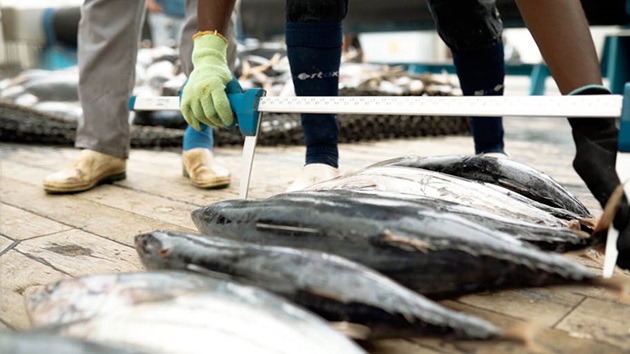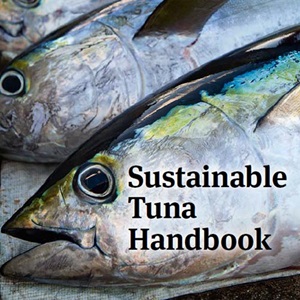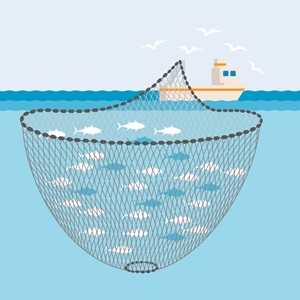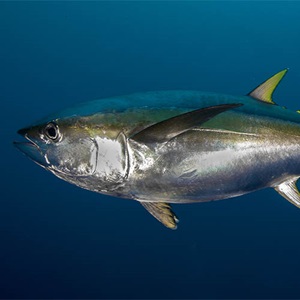Is FAD fishing sustainable? Find out why FADs are so frequently used to catch tuna and how they can be used sustainably.
What are FADs?
Fish Aggregating Devices (FADs) are man-made, usually floating wooden structures with hanging nets to attract fish. These rafts can either be free floating (known as drifting FADs or dFADs) or anchored to the seabed (known as anchored FADs or aFADs).
Some tuna fisheries also target natural structures or objects, including free-floating logs (tree trunks) and large marine animals, such as whale sharks, around which fish congregate. This is referred to as 'natural-associated' or 'object-associated' fishing.
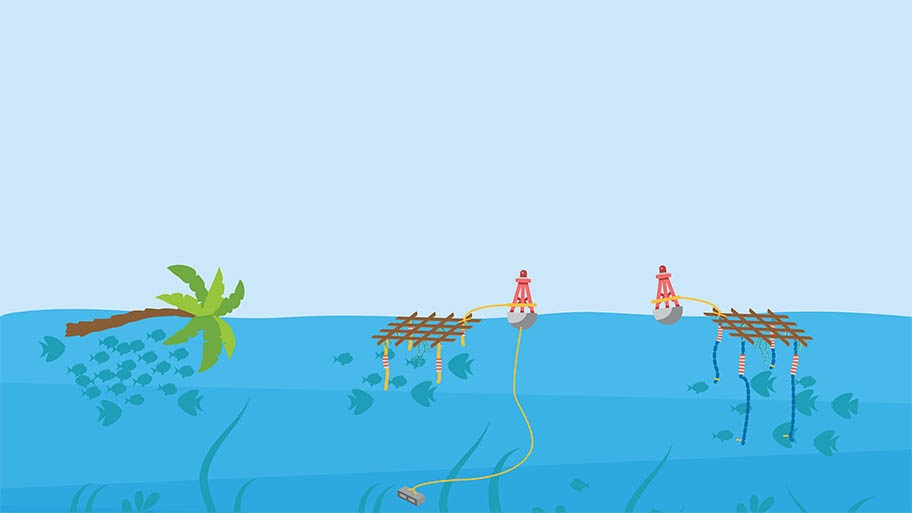
Natural FAD, Anchored FAD (aFAD) and drifting FAD (dFAD)
Drifting FADs are commonly used alongside purse seine nets.
According to the International Seafood Sustainability Foundation (ISSF), FADs are used in 65% of purse seine sets and in 40% of the world’s skipjack catch.
Why do tuna fisheries use FADs?
Tuna are highly migratory, ranging over thousands of miles. Some fishers track tuna or follow their migration in order to catch them - this is called ‘free school’ fishing. Other fishers use FADs to help them locate and catch the tuna more easily.
By deploying their nets and casting their lines close to FADs, tuna fishers can significantly increase their catches, reducing the time spent at sea and therefore the cost of catching tuna.
What are the problems with using FADs?
A wide variety of marine life including turtles and sharks congregate around FADs. These species can become entangled in the floating nets attached to FADs.
Such "non-target" species can also be caught as bycatch (accidental catch) in the nets or lines fishers cast from their boats to catch the tuna. As a result, bycatch can be high when fishing around FADs, particularly in comparison to free school fishing, where nets are set in the open water.
High amounts of bycatch can have detrimental impacts on the ecosystem. FADs can also increase the capture of juvenile tuna, putting the sustainability of some tuna stocks at risk.
However, species interact differently with different types of FADs, and different fishing techniques can make dramatic differences in the level of bycatch.
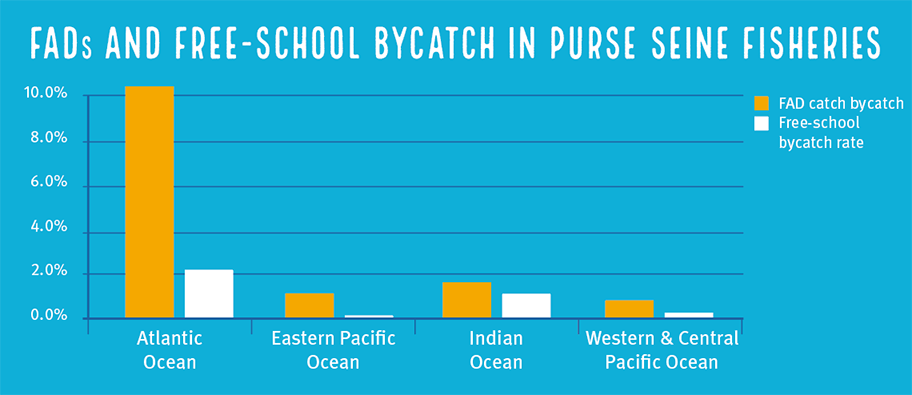
In addition to bycatch concerns, the potential effects of FADs on the migratory patterns of tuna are the subject of ongoing research. The impacts of lost or derelict FADs on habitats such as coral reefs and in contributing to ocean plastic are also a concern.
With an estimated 81,000-121,000 FADs deployed worldwide each year, the cumulative impact of FADs can be damaging if not managed effectively.
What can be done to reduce the impacts of FADs?
Significant progress has been made in recent years to reduce the negative impacts of FADs. Tuna fisheries, in partnership with research institutions, are developing technological improvements in FAD design. For example, some fisheries are adopting the use of biodegradable and non-entangling drifting FADs to reduce their persistence in the marine environment and reduce the capture of non-target species.
These efforts, combined with improved tracking and data collection, licensing and registration of FADs, monitoring and retrieval of old FADs, and purse seine gear modifications, have enabled fisheries using FADs to reduce their impacts to levels at which sustainable certification is a possibility.
In 2018, the MSC awarded a Student Scholarship Grant to a postgraduate student who identified a new method of tracking anchored FADs in Indonesian waters. The aFads used by small-scale Indonesian fishers are locally known as "rumpon" and often consist of coconut or palm leaves used to attract fish with their aromas.
Despite new government regulations being introduced to manage aFADs in the western Pacific Ocean, rumpon remain largely undocumented and overfishing can quickly occur. Analysis showed that by engaging the local fishing community to voluntarily fix satellite trackers to their vessels, FAD use patterns can be identified and the chance of overfishing reduced.
What is the MSC’s approach to FADs?
Certification to the MSC Fisheries Standard is based on comprehensive assessment of the impacts of a particular fishery and the environment within which it operates.
The latest version of the MSC Fisheries Standard, published in October 2023, contains strengthened requirements to minimise gear loss and mitigate the impacts of lost gear. These requirements also apply to FADs: fisheries now need to account for any FADs that are lost and be able to demonstrate they are avoiding and managing this loss. This includes tracking or retrieving FADs, or showing they are low impact by being non entangling and biodegradable.
All fisheries, regardless of their fishing techniques, must also demonstrate that rates of bycatch do not pose a long-term threat to any species within the ecosystem where they operate.
In the past, few fisheries using drifting FADs have been assessed to the MSC Fisheries Standard due to a lack of understanding of the impacts, or high bycatch rates. More recently, however improvements in FAD design, research, and management have made assessment possible.
The Decision: A tuna fishery’s quest for sustainability
Growing sustainability in FAD tuna fishing
The first tuna fishery using drifting FADs achieved MSC certification in 2018. Working with the Indian Ocean Tuna Commission and Seychelles authorities, the Echebastar purse seine tuna fishery has actively sought to reduce bycatch of non-target species by reducing numbers of FADs, deploying only non-entangling FADs and ensuring the rapid release of non-target species. The fishery has continued to make improvements since certification.
In 2020, alongside research partners AZTI, Echebastar received an Ocean Stewardship Fund grant to support these improvements. The project has successfully tagged 28 silky sharks with satellite tags in order to better understand post-release mortality rates and further improve bycatch mitigation. It is also supporting the FAD Watch initiative in the Seychelles which intercepts lost FADs to prevent impacts to local coral reefs.
Several other purse seine tuna fisheries that catch tuna using drifting FADs have also since achieved certification, including the PNG Fishing Industry Association’s purse seine Skipjack & Yellowfin Tuna Fishery in May 2020 and the WPSTA Western and Central Pacific Skipjack and Yellowfin Purse Seine Fishery in June 2021.
We believe that by incentivising sustainable tuna fishing, the MSC program can be part of an evolution to enabling more sustainable fishing practices. In the case of tuna fishing this is driving uptake of new ways of reducing impacts of FAD use – and stricter controls to ensure that these are followed.
We see considerable research being undertaken by the fishing industry to reduce the environmental impacts of FADs. Through these innovations and improvements, we believe that fishers can continue to catch tuna in a way which is both profitable and sustainable.

